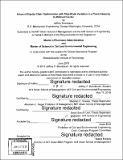| dc.contributor.advisor | Stephen C. Graves and David Simchi-Levi. | en_US |
| dc.contributor.author | Birenbaum, Jeffrey (Jeffrey P.) | en_US |
| dc.contributor.other | Leaders for Global Operations Program. | en_US |
| dc.date.accessioned | 2018-09-17T15:52:30Z | |
| dc.date.available | 2018-09-17T15:52:30Z | |
| dc.date.copyright | 2018 | en_US |
| dc.date.issued | 2018 | en_US |
| dc.identifier.uri | http://hdl.handle.net/1721.1/117981 | |
| dc.description | Thesis: M.B.A., Massachusetts Institute of Technology, Sloan School of Management, in conjunction with the Leaders for Global Operations Program at MIT, 2018. | en_US |
| dc.description | Thesis: S.M., Massachusetts Institute of Technology, Department of Civil and Environmental Engineering, in conjunction with the Leaders for Global Operations Program at MIT, 2018. | en_US |
| dc.description | Cataloged from PDF version of thesis. | en_US |
| dc.description | Includes bibliographical references (pages 73-74). | en_US |
| dc.description.abstract | each of the past two years. In order to scale with expected continued sales growth, Amazon has been investing heavily in its inbound supply chain, where product is received and allocated to various nodes, with cross-dock facilities, Amazon Robotics fulfillment centers and traditional fulfillment centers constituting a multi-echelon distribution network. In an Amazon Robotics fulfillment center, robotic drives retrieve and deliver portable inventory pods, where product is stowed and picked at fixed stations. Currently, approximately 65% of associate hours within the inbound department are utilized in the direct process of stow, while the other 35% of associate hours in the inbound department are utilized in support of the stow process in tasks such as corrugate removal and product container management. As a result, there is a continued emphasis on improving the efficiency of the nonvalue added tasks utilized in support of the stow process in order to utilize as many hours as possible in the value-added stow process. This thesis proposes a linear optimization-based analysis framework and capital allocation model that can be utilized to determine the investment viability for different automation systems and process improvements, which could improve efficiency and reduce overall cost in the Amazon Robotics fulfillment centers. This is especially the case within those fulfillment centers that are labor constrained. Labor constraints within a fulfillment center result in artificial limits set within Amazon's inventory placement algorithm, changing the origin of the shipment of product(s) to customers, which results in additional outbound transportation cost. This study will uncover unrealized cost-improvement areas by suggesting an inbound conveyance solution that can improve upon the current human-powered inbound system, and provides further areas of investigation for additional improvement. Implementation of the selected automation solution reduces inbound department hours by -3% with a payback period of -0.93 years for the fulfillment center in question, while improving labor-constrained fulfillment center capacity by as much as 1 %, and suggests further areas of investigation that can improve overall cost within the inbound supply chain by over 10%. | en_US |
| dc.description.statementofresponsibility | by Jeffrey Birenbaum. | en_US |
| dc.format.extent | 74 pages | en_US |
| dc.language.iso | eng | en_US |
| dc.publisher | Massachusetts Institute of Technology | en_US |
| dc.rights | MIT theses are protected by copyright. They may be viewed, downloaded, or printed from this source but further reproduction or distribution in any format is prohibited without written permission. | en_US |
| dc.rights.uri | http://dspace.mit.edu/handle/1721.1/7582 | en_US |
| dc.subject | Sloan School of Management. | en_US |
| dc.subject | Civil and Environmental Engineering. | en_US |
| dc.subject | Leaders for Global Operations Program. | en_US |
| dc.title | Inbound supply chain optimization with ship-mode variation in a fixed-capacity fulfillment center | en_US |
| dc.type | Thesis | en_US |
| dc.description.degree | M.B.A. | en_US |
| dc.description.degree | S.M. | en_US |
| dc.contributor.department | Leaders for Global Operations Program at MIT | en_US |
| dc.contributor.department | Massachusetts Institute of Technology. Department of Civil and Environmental Engineering | |
| dc.contributor.department | Sloan School of Management | |
| dc.identifier.oclc | 1051238371 | en_US |
